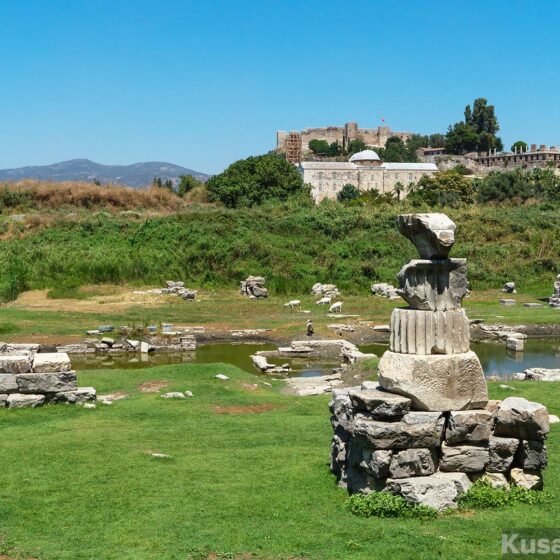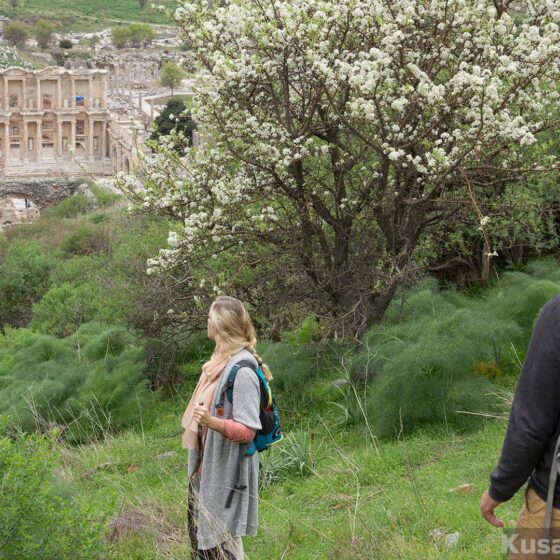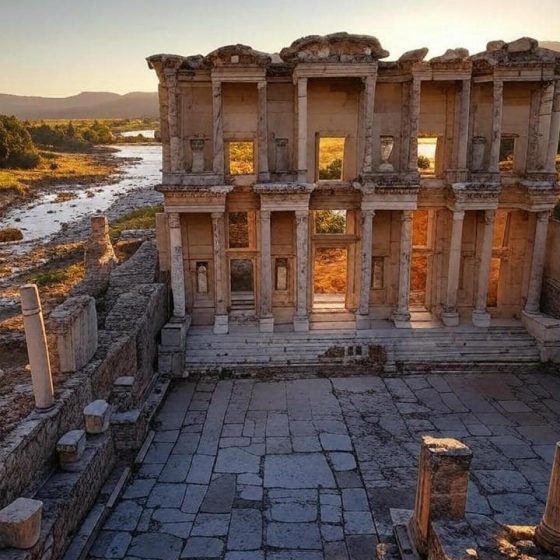Ephesus is full of grand sights; Library of Celsus, Great Theatre, and the ruins of temples that once defined the city. But hidden among the stone paths and fallen columns are markings that most visitors never notice. These carvings, symbols, and patterns tell a deeper story about the people who once lived here. Some were meant as messages for protection, others as directions, and some remain a mystery.
What do these symbols mean? Who left them behind? And why do they still survive after centuries?
The Ancient “Christian Code” on the Streets of Ephesus
One of the most well-known hidden symbols in Ephesus is the Ichthys, or the “Jesus Fish.” Early Christians, who were often persecuted, used this simple fish symbol to identify themselves. The Greek letters inside the fish—ΙΧΘΥΣ (Ichthys)—stood for “Jesus Christ, Son of God, Savior.”
But there’s another secret Christian symbol carved into the streets of Ephesus, often overlooked by visitors. It’s a simple circle divided by lines into eight sections, creating an X-like pattern inside. To the average tourist, it looks like a random design, but it’s actually a secret code for Christians. By drawing a certain part of the symbol, one Christian could check if another person was also a believer without exposing themselves to danger.
This symbol can still be found near the Library of Celsus and the Great Theatre.
See also: Book Your Ephesus Tour Today
The Markings of Ancient Merchants
Walking through Ephesus, you might spot small carvings of feet, coins, or lines on some of the stones. These were not decorations—they were early business signs.
One of the most famous carvings in Ephesus shows a foot, a woman’s face, and a heart. This is believed to be an advertisement for a brothel. The message was simple: follow the direction of the foot, pay with coins, and you’ll find love (or at least companionship).
Other carvings acted as shop signs. Since many people in the ancient world could not read, merchants used symbols instead of words to mark their stores. A carving of an amphora (a type of jar) might indicate a shop selling wine or oil, while a set of coins could mean a moneylender was nearby.
See also: What Makes Ephesus a Must Visit Destination in 2025?
The Hidden Symbols of the Library of Celsus
The Library of Celsus is one of the most famous landmarks in Ephesus, but even here, there are details that most tourists never notice.
Look closely at the statues on the library’s facade. There are four women, each representing a different quality valued by the ancient world: Sophia (Wisdom), Arete (Excellence), Ennoia (Intelligence), and Episteme (Knowledge). These were not just decorative—they were meant to remind visitors of the purpose of the library: to educate and inspire.
There’s also a hidden Roman symbol on the library. A small carving of a laurel wreath can be found on the upper parts of the structure, symbolizing victory and eternal glory. This was likely placed there by the builders to honor Tiberius Julius Celsus, the Roman governor for whom the library was built.
The Goddess Carvings on the Temple of Hadrian
The Temple of Hadrian, one of the most well-preserved structures in Ephesus, contains carvings that reveal the city’s ancient beliefs. Above the entrance, you’ll find a depiction of Tyche, the goddess of fortune, along with Medusa, whose face was meant to protect the temple from evil spirits.
Even more fascinating is the procession of the Amazons carved along the temple walls. These warrior women were part of Greek mythology, but some historians believe the Amazons were inspired by real-life female fighters from Anatolia. The fact that they were included in Ephesus’s temple decorations suggests they had an important cultural role in the region.
See also: Top Rated Kusadasi Tours
The Mysterious Greek Inscriptions
Scattered throughout Ephesus are Greek and Latin inscriptions, many of which tourists walk past without noticing. Some of these were official announcements or laws, while others were personal messages left behind by citizens.
One inscription, found near the agora (marketplace), reads:
“Let no one act against the will of the gods, for their wrath is stronger than any army.”
This was likely a warning, meant to remind people of the power of divine justice. Other inscriptions are more practical, such as names of donors who helped fund the construction of certain buildings.
The Crescent and Star: A Symbol Older Than Expected
Today, the crescent and star are known as symbols of Turkey, but few people realize this design has ancient roots. In Ephesus, carvings of a crescent moon and star can be found on old city walls. Historians believe these symbols were linked to Artemis, the city’s patron goddess, whose temple once stood here.
Some believe that over time, these symbols were adopted by later cultures, eventually becoming part of the flags and emblems we recognize today.
What These Symbols Tell Us About Ephesus
While most tourists focus on the grand ruins of Ephesus, these small carvings and markings reveal the real life of the city. They show us how people communicated, how they conducted business, and how they protected themselves in dangerous times.
If you visit Ephesus, take a moment to look beyond the obvious. The city’s secrets are hidden in plain sight, waiting to be noticed by those who pay attention.
Last updated on February 15, 2025



